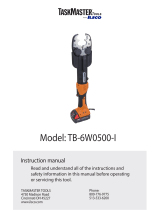TO REDUCE THE RISK OF IN-
JURY, CHARGE MILWAUKEE
M12™ AND M18™ RECHARGEABLE LI-ION
BATTERIES ONLY IN MILWAUKEE M12™ AND
M18™ LI-ION CHARGERS. Other types of batter-
ies may burst causing personal injury and damage.
Do not wire a battery pack to a power supply plug
or car cigarette lighter. Batteries will be perma-
nently disabled or damaged.
4. USE MILWAUKEE LI-ION PACKS ONLY ON
COMPATIBLE MILWAUKEE LI-ION TOOLS.
Battery pack and charger are not compatible with
V™-technology or NiCd systems. Use with other
tools may result in a risk of re, electric shock or
personal injury.
5. AVOID DANGEROUS ENVIRONMENTS. Do not
charge battery pack in rain, snow, damp or wet
locations. Do not use battery pack or charger in
the presence of explosive atmospheres (gaseous
fumes, dust or flammable materials) because
sparks may be generated when inserting or remov-
ing battery pack, possibly causing re.
6. CHARGE IN A WELL VENTILATED AREA. Do not
block charger vents. Keep them clear to allow
proper ventilation. Do not allow smoking or open
ames near a charging battery pack. Vented gases
may explode.
7. ALWAYS PLACE THE DC CHARGER ON A
LEVEL, WELL VENTILATED SURFACE (e.g. not
on a car seat). If charging while the vehicle is in
motion, the driver should not attempt to install or
remove any battery until the vehicle has come to a
stop and it is safe to do so. Ensure the DC charger
and battery packs are secured when the vehicle is
in motion.
8. MAINTAIN CHARGER CORD. When unplugging
charger, pull plug rather than cord to reduce the risk
of damage to the electrical plug and cord. Never car-
ry charger by its cord. Keep cord from heat, oil and
sharp edges. Make sure cord will not be stepped
on, tripped over or subjected to damage or stress.
Do not use charger with damaged cord or plug.
Have a damaged charger replaced immediately.
9. DO NOT USE AN EXTENSION CORD UNLESS IT
IS ABSOLUTELY NECESSARY. Using the wrong,
damaged or improperly wired extension cord could
result in the risk of re and electrical shock. If an
extension cord must be used, plug the charger
into a properly wired 16 gauge or larger extension
cord with pins that are the same number, size and
shape as the pins on the charger. Make sure that
the extension cord is in good electrical condition.
10. CHARGER 48-59-1810 IS RATED FOR 24 VOLT
DC AND 12 VOLT DC. CHARGER 48-59-1812 IS
RATED FOR 120 VOLT AC ONLY. Charger must
be plugged into an appropriate receptacle.
11. USE ONLY RECOMMENDED ATTACHMENTS.
Use of an attachment not recommended or sold
by the battery charger or battery pack manufac-
turer may result in a risk of re, electric shock or
personal injury.
12.
UNPLUG CHARGER when not in use. Remove
battery packs from unplugged chargers.
13. TO REDUCE THE RISK OF ELECTRIC SHOCK,
always unplug charger before cleaning or mainte-
nance. Do not allow water to ow into AC/DC plug.
Use a Ground Fault Circuit Interrupter (GFCI) to
reduce shock hazards.
14. DO NOT BURN OR INCINERATE BATTERY
PACKS. Battery packs may explode, causing per-
sonal injury or damage. Toxic fumes and materials
are created when battery packs are burned.
15. DO NOT CRUSH, DROP, OR DAMAGE battery
pack. Do not use a battery pack or charger that
has received a sharp blow, been dropped, run
over, or damaged in any way (e.g., pierced with
a nail, hit with a hammer, stepped on).
16. DO NOT DISASSEMBLE. Incorrect reassembly
may result in the risk of electric shock, re or
exposure to battery chemicals. If it is damaged,
take it to a MILWAUKEE service facility.
17. BATTE
RY CHEMICALS CAUSE SERIOUS
BURNS. Never allow contact with skin, eyes, or
mouth. If a damaged battery pack leaks battery
chemicals, use rubber or neoprene gloves to dispose
of it. If skin is exposed to battery uids, wash with
soap and water and rinse with vinegar. If eyes are
exposed to battery chemicals, immediately ush
with water for 20 minutes and seek medical atten-
tion. Remove and dispose of contaminated clothing.
18. DO NOT SHORT CIRCUIT.
A battery pack will short
circuit if a metal object makes a connection between
the positive and negative contacts on the battery
pack. Do not place a battery pack near anything
that may cause a short circuit, such as coins, keys
or nails in your pocket. Do not allow uids to ow into
battery pack. Corrosive or conductive uids, such as
seawater, certain industrial chemicals, and bleach or
bleach containing products, etc., can cause a short
circuit. A short circuited battery pack may cause
re, personal injury, and product damage.
19. STORE YOUR BATTERY PACK AND CHARGER
in a cool, dry place. Do not store battery pack
where temperatures may exceed 120°F (50°C)
such as in direct sunlight, a vehicle or metal build-
ing during the summer.
IMPORTANT SAFETY INSTRUCTIONS






